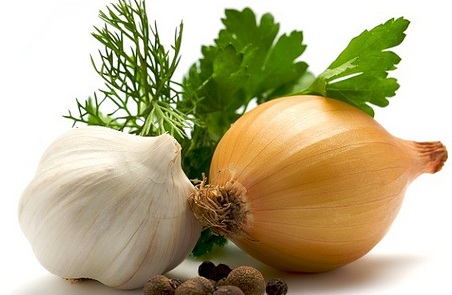
Onions and garlic
Various types of onion, including spring onions, pickling onion and shallots can be successfully grown from sets or from seed, some from both.
Onion sets
Onion sets are small, immature onions, planted in spring or late summer. The sets increase in size and each forms one full-sized bulb when ready to harvest. Where possible, choose onion sets that have been heat-treated. This means their flower embryos have been killed, so they’re less likely to run to seed or bolt. Generally, growing onions from sets is easier and more reliable than from seed and in cooler, damper areas, the sets should give a better yield of larger bulbs than if grown from seed. However the range of varieties available is far greater if growing onions from seed.
What to do
Soil preparation
- A sunny, well-drained site is essential for growing good crops of onion and garlic. It’s possible to grow good onions on heavy soil, but the drainage should be improved prior to planting with grit and bulky organic matter, and the cloves planted in ridges of soil 10cm (4in) high to help reduce soil moisture.
- Onions and garlic both like fertile soil, but neither require much nitrogen and so shouldn’t be grown on freshly manured soil. Instead, dig over and manure the ground several months before planting. If the soil is acid it’s worth liming it so its pH level becomes neutral or even slightly alkaline.
How to sow seed
- Sow seed in modules in January or February at 10-15°C (50-59°F).
- Sow five or six seeds per module in damp seed compost – when planted out the clumps of bulbs will push themselves apart as they expand.
- Cover seeds with a layer of vermiculite and label with variety name and date of sowing.
- To have a year-round supply, you can sow once in spring for harvesting from August, and again in late summer or autumn to be ready from June, although a second planting isn’t recommended in very heavy, wet soils. Onions should be given as long a growing season as possible to reach maximum size.
Growing onions from sets
- The easiest way to grow onions is from sets, available from garden centres.
- Prepare the soil a couple of months before planting by digging over and adding manure.
- Plant the sets in spring in shallow drills and cover them so the necks are just protruding from the soil.
- Weed regularly and water sparingly.
- Harvest as soon as the foliage starts to yellow.
Growing tips
- Regular weeding is essential – because of the way their leaves are held upright, onions aren’t good at supressing weed growth and, if left for too long, weeds will soon swamp the crop and cause damaging competition.
- Bolting, or running to flower, can be a common problem with onions, especially if there’s a late cold spell or they suffer hot, dry conditions. Choosing heat-treated sets or late-maturing varieties will reduce the likelihood of bolting.
Harvesting and storage
- As soon as the leaves start to yellow and die back, onions and garlic are ready for harvesting. Don’t bend over the leaves to speed this up.
- Lay the bulbs, complete with foliage, in a warm, dry place for a couple of weeks to dry out. If onions develop thick necks use these straight away as they don’t store well and are prone to neck rot.
- Make sure the foliage is completely dry before storing the crop in a dark, cool, dry place, either by hanging in nets or plaits, or packing carefully in layers in boxes. Storage life depends on the cultivar but is usually 3-6 months.
Pests and diseases
- Onions can be prone to various fungus-borne diseases which makes it worthwhile to rotate the position of your onions each year. It’s also worth always buying fresh sets each year from a reputable supplier to avoid the viral diseases that garlic in particular is prone to.
- Onion neck rot – fluffy grey fungal growth around the neck leads to softening of the tissues. Infected areas turn transparent and may start to dry out. Avoid by always purchasing sets from a reputable source and not growing onions on the same site more than two years running. Onions with red or yellow bulbs are less affected than white ones.
- Onion white rot – a dense fluffy fungal white growth around the roots and base of the bulb. If you find it, remove and burn infected plants promptly, and don’t grow onions on the same site for at least eight years. There’s no chemical control or resistant varieties.
- Onion fly – onions are particularly prone to this larval fly but shallots, leeks and garlic may also be attacked. The larvae eat the roots of the bulbs and may burrow into them in late summer. Growing onions from sets reduces the problem, as does interplanting with carrots to mask the smell. If you discover an infestation, remove infested bulbs promptly before the larvae move into the soil to pupate.
- Onion thrips – a fine white mottling on the foliage indicates an attack on onions or leeks. They’re tiny yellow or black bodied insects about 2mm long and are particularly troublesome in hot, dry weather. The damage to leaves can result in smaller crops.

